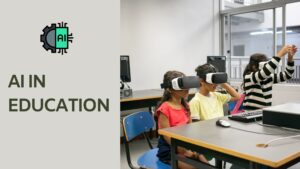
AI in Education Is a Game Changer, and So Is Robotic
AI technology has become inevitable in various facets of our lives. Integration of AI into education, alongside robotics, has revolutionized the ever-evolving educational landscape. They redefine the approaches of both teachers and students. The presence of AI in education brings innovative teaching and learning methods that equip students to face the technology-driven world.
In this blog, we will discuss the pivotal roles that AI and robotics play in education.

AI in Education
The use of AI in education has the potential to transform the way students learn and educators teach. With the entry of AI in education, there is scope for dynamic changes in the education sector. Here are a few areas where AI can play its role.
# 1. Personalised learning
AI in education is not a substitute for teachers, rather it is there to support teachers and students and plays a transformative role in delivering personalized learning experiences to students. With AI, educators can easily make customized modules aligning with each student’s unique level, pace, and requirements. Thus, schools can embrace the uniqueness of each student effortlessly.
#2. Virtual Reality
Virtual Reality has been gaining momentum in classrooms. The immersive 3D environment it generates for subjects is a significant outcome of the integration of AI in education. Moreover, VR fosters engagement and makes learning more interesting. Virtual reality enables students to learn and discover things they would never have the opportunity to experience in real life.
#3. Streamlining educators’ tasks
Teachers’ roles go beyond teaching, and various activities demand their time. For instance, grading tests and other similar activities require extensive time and effort. Here, Artificial Intelligence emerges as a helping hand and saves valuable time. These tools have been rapidly progressing and possess the potential to automate the grading process.
#4. AI in education generates smart content
AI in education makes content more engaging and interactive for students. With the assistance of virtual tutors, chatbots, and other innovative learning methods, AI makes the learning resources and contents more effective and engaging.
Why do we need Robotics In Education?
Robotics is a promising discipline that bears the potential to enhance the quality of education. It redefines teaching methods and learning environments. For instance, educational robots can improve various skill sets of students including creativity, computational thinking, problem-solving, etc. Moreover, Robotics helps students in gaining in-depth knowledge in languages, mathematics, and other subjects. The Robotics curriculum equips students with skills that are needed to thrive in today’s job market. Moreover, there are numerous career options in Robotics and automation in this digital era.
Here are some key areas where Robotics play wonders.
#1.STEM Education
Accommodating Robotics in the curriculum helps to make STEM subjects more engaging and accessible. Similarly, Robotics equips students with the technical and problem-solving skills required to excel in the dynamic STEM fields.
#2.Students with special requirements
Otherwise, abled students encounter difficulties in accessing education. They require additional care and relentless support. Robots can be programmed with inputs that meet each student’s requirements. Robotics and AI in education assist these students in getting education in an accessible format. Thus, by leveraging the potential of AI, we can demolish the barriers and ensure every student irrespective of their abilities has access to quality education.
#3.Real-World Applications
With proper guidance and opportunities, students can work on robotics projects that address real-world challenges. For instance, they can design and develop robots that can solve issues in various fields such as agriculture, healthcare, environment, etc.
How Asoka World School Integrates AI and Robotics in Education?
AI integrated curriculum

As AI and Robotics have made inroads into every facet of human life, we should focus on building a generation that can control and master these advancements for the betterment of humanity. Hence, along with IT, Asoka World School, one of the best CBSE Schools in Kochi has embraced these cutting-edge technological advancements and integrated them into the school curriculum.
These modules accommodate a wide range of topics from fundamentals of electronics to Robotic systems. Accordingly, in Robotics, we have an in-depth exploration of electronics, including circuit design and components like microcontrollers. Further, the curriculum integrates modules to equip students with the knowledge to build and programme more advanced tools. Similarly, we provide platforms for students to learn and explore real-world applications of robotics in diverse fields, such as healthcare, manufacturing, and space exploration. Moreover, we conduct exhibitions and workshops to introduce students to the world of AI and robotics.
Furthermore, we provide add-on courses. As a result, our students get the opportunity to get familiarised with various software. Additionally, they get chances to explore the latest trends in cyber technologies and the Internet of Things which are integral to gaining mastery over artificial intelligence. Likewise, we have classes to impart knowledge on quintessential facets of IT such as ethical and legal issues, copyright, privacy, and digital rights.
How AI and Robotics Nurture Young Minds?
They explore a new idea
Robotics and AI in education encourage students to think out of the box. The hands-on practical experience they get combined with fresh concepts, enable them to design and develop robots. It gives them a sense of achievement, motivating them to innovate. Therefore, learning Robotics gives them the confidence to generate ideas and build new things.
Enhance motor skills
Assembling and connecting tools and components enhance children’s motor skills. Similarly, programming robotis helps them develop finger dexterity and hand-eye movement.
Fosters Entrepreneurial Spirit
Educational robots encourage children to try and experiment with novel concepts. As a result, they learn to think and innovate independently. In the future, it paves the way for embarking on the entrepreneurial journey.
Robotics fosters creative thinking
AI in education demands children to indulge in finding solutions to real-world problems. Thus they explore new and unconventional ideas. Similarly, they encounter challenges in Robotics. It prompts them to think creatively for solutions. Moreover, the experimentation and adaptation involved in Robotics help them to think creatively.
STEM subjects become their favorite.
Robotics encompasses subjects such as physics, maths, materials, computer science, etc. The hands-on approach in Robotics enhances children’s understanding of these subjects. Moreover, they find these subjects interesting and engaging. Thus STEM subjects become a cakewalk for them.
AI in education helps develop problem-solving skills.
AI in education arranges avenues for enhancing problem-solving skills enabled by educational tools to create interactive problem-solving platforms. These tasks challenge students and urge them to develop solutions. Further, AI tools guide children with suggestions. Eventually. children start developing problem-solving skills.
Teamwork and collaboration
Robotics and AI projects involve task delegation, mutual support, resource sharing, etc., to reach the destination. It instills collaborative skills and teamwork in children. Thus, children’s active participation in Robotics makes them learn the crucial role teamwork plays in any project.
Conclusion
From chatbots that offer prompt assistance to personalised learning powered by AI, the education sector is undergoing a promising transformation. These innovations not only augment the students’ skills but also open a brighter future for them. Embracing these technological advancements is the key to unlocking the world of opportunities.


